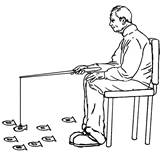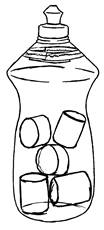renewal cycles. Complete
some now & some later.
and Get 25% off
the Total price!
Buy 3 Courses
and Get 30% off
the Total price!
Buy 4 Courses
and Get 35% off
the Total price!
| Create Account | Login | |

Section 20
Fish Game & Marshmallow Guess
Table of Contents | NCCAP/NCTRC CE Booklet
Part IV
Instructor’s Implementation Guide
Activities that are Fun and/or Productive
Part IV Note: As mentioned earlier in this Manual, you may be lucky enough to have a handful of low-functioning residents that are alert enough to hold the concept of “Game Rules” in their mind. Also, as mentioned earlier, since so few residents fit into this category, this is by far the shortest section of the Manual. However, since these are simple, fun, and/or productive activities, they do have a certain success rate with the higher end of your low-functioning residents.
Fish Game
 (The last track of the DVD that accompanied this course contains slide(s) illustrating implementation of this activity.)
(The last track of the DVD that accompanied this course contains slide(s) illustrating implementation of this activity.)
For the fish game, think of your resident who has grasping ability in at least one hand; has an attention span of at least five minutes; and is aware of a cause-and-effect relationship. By “cause-and-effect relationship,” I mean the resident makes the connection between trying to guide the fish line over a fish, and picking it up.
To create a Fish Game, you can start with a dowel rod about 1/2” in diameter and about 3 feet long. Staple a piece of yarn to the end of the dowel rod. Cut simple fish shapes out of construction paper or poster board. At the end of the yarn, where the fish hook would be, tie a paper clip. Glue magnets to the fish. Many craft stores have magnets that have adhesive on the back. Another way to have the fish line affix to the fish is to use hooked Velcro and felt or napped fabric fish. However, the advantage of the magnets and paper clip are that the resident has a greater chance of success, since the paper clip is actually drawn towards the magnet on the fish, which of course is not the case if you use Velcro. In regards to providing CMS “Person Appropriate” Activities, clearly, one benefit regarding the Fish Game is that your resident can relate the game to his or her possible past interest in fishing. You might even work out some type of reward system or prize.
The Fish Game can be adapted for your resident to sit in a chair. The fish might be placed on a table, the floor or on the resident's bed. Also, residents who are sitting in bed can do the fish game, as indicated in the slides on the DVD, with the fish being placed at the ends of their beds. The advantage of the Fish Game is that you do not need a Work Surface for this activity.
| Goal: To play the Fish Game with physical assistance by guiding the pole to pick up a fish… |
Goal: To play the Fish Game independently with assistance removing the fish… |
Residents with whom to try the Fish Game
Resident |
Who will gather materials and/or construct project? |
Staff /Volunteer to work with resident? When? |
|
|
|
|
|
|
|
|
|
Culture Change Implementation: Place Fish Game in labeled Activity Project Bag left in resident’s room for CNA, volunteer, etc. use.
Marshmallow Guessing
 (The last track of the DVD that accompanied this course contains slide(s) illustrating implementation of this activity.)
(The last track of the DVD that accompanied this course contains slide(s) illustrating implementation of this activity.)
Guess games can sometimes be successful with disoriented residents provided they are structured correctly. I have had the most success with the Marshmallow Guess game. Obviously, the object of this Guess Game is to guess how many marshmallows, jelly beans, etc. are in the container. I find a clear plastic dish detergent bottle works best because it is clear; of a size that can be handled easily; and it cannot be broken. Cut the top off of the bottle with a serrated steak-type knife and scissors. Once you make a slit big enough with the knife for your scissors blade to fit in, cut the remainder with the scissors. Then fill the bottom part of the bottle with large marshmallows, small marshmallows, or jelly beans and use scotch tape to affix the two pieces back together
Now here is the key to the success of the Marshmallow Guess game. For less alert residents, the large marshmallows provide more of an opportunity for success.
The larger the items are, the more encouraged the resident is to guess.
I found residents that refused to guess how many jelly beans or small marshmallows were in the bottle, would guess how many large marshmallows were in the bottle. Remember, of course, the idea is to create a successful experience. You might even help your resident count. For residents with Alzheimer's whose short term memory is failing, I have found you can return to that resident repeatedly with the same container of marshmallows and they will try to guess each time, as if they have never played the guess game before. So, the same Marshmallow Guess game can be used in repeated sessions. You might vary the number of marshmallows by removing or adding some, if you feel the resident is alert enough to be aware of this variation.
The Sesame Street Technique:
Here is how I would implement Marshmallow Guessing:
1. Introduce the activity by saying, "Freida, I've got something for you to guess. I bet you can figure out how many marshmallows I have in the container today!" As you say this, you are showing her the container.
2. Then, take your or her index finger, if appropriate, and say, pointing to a marshmallow in the container, "Let's see, here is one." (and point) "Here is two. (and point) "
3. "Here is…" Stop and wait for her to hopefully say "three."
4. To prompt her to say three, repeat, "Here is… let's see, one, two, hmmm, what's the next number? Let's see."
5. "One, two, gosh, what is it? It's, mmm, what is that? One, two, thr… thr… Freida, what is the next number after one and two?"
6. "Let's see, it's one, two, and t-h-r-e-e."
I call this the Sesame Street technique. The idea is for you to structure your monologue in such a way \that hopefully your Freida cannot help but say the number three.
Clearly, you gauge the amount of verbal prompting your particular Freida needs. You might reread the section under Bead Stringing regarding finding the fine line between challenging and frustrating the resident as well, since it compliments this concept of the Sesame Street Technique.
Goal: To count three marshmallows in the Marshmallow Guess game… |
Goal: To use index finger to count number of Marshmallows in a Guess Game… |
Goal: To react with a smile when receiving praise after Guess Game… |
Residents with whom to try Marshmallow Guess
| Resident | Who will gather materials and/or construct project? |
Staff /Volunteer to work with resident? When? |
|
|
|
|
|
|
|
|
|
Culture Change Implementation: Place Marshmallow Guess in labeled Activity Project Bag left in resident’s room for CNA, etc. use.
NCCAP/NCTRC CE Booklet
Forward to Section 21
Back to Section 19
Table of Contents
Top


